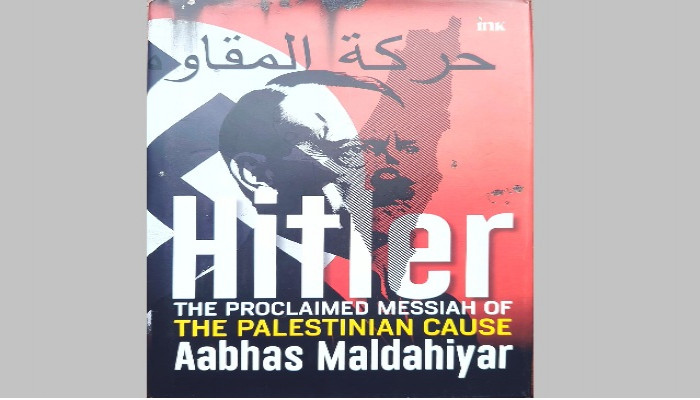Hitler: The Proclaimed Messiah Of The Palestinian Cause
- In Book Reviews
- 05:19 PM, Sep 11, 2025
- Ramaharitha Pusarla
At times, startling revelations and uncanny disclosures made in books spark an appetite to delve deeper into the subject to satisfy curiosity. Months after the gruesome Hamas terror attack in Israel in October 2023, the world witnessed a surge of ‘from river to sea’ slogans renting the air. The partisan debates, one-sided attacks and bold calls for the liquidation of Jews with vehemence were hardly met with any counter. The book, “Israelophobia: The Newest Version of the Oldest Hate & What To Do About It” by Jake Wallis Simon, deciphered the oldest hate and unabashedly exposed the various players of this punitive discourse.
The book drops a truth bomb of the Palestinian Grand Mufti of Jerusalem, Hajj Amin al-Husseini’s Lemonade Summit with Führer Hitler. Husseini, who harboured the dreams of becoming the ruler of the Arab world, leveraged Hitler’s hatred for Jews as the gel to forge a bond with the Nazi ruler. Placing Islam in high esteem, reportedly, Hitler had portrayed ‘Islam as a strong and practical faith’ and described Christianity as a ‘soft, artificial, weak religion of suffering’. In one of his memoirs, Husseini boastfully claimed that he supported the Nazis, “because I was persuaded and still am that if Germany had carried the day, no trace of Zionists would have remained in Palestine (P 140)”. This was a revelation for me. Since then, I longed to learn more about the collaborative scheme that vowed to destroy world Jewry. Buried in the annals of history, this coalition forged in ideology and smelted in the embers of hatred with profound implications was dismissed as rhetoric and forsaken. This collaboration, fuelled by shared loathing, hardly garnered international attention, thanks to the swift portrayal of Arabs as the victims.
Far removed from the Nazi and Arab scheming, back home, Hitler’s fascism turned out to be the popular stick to beat ‘Hindutva’. Ironically, the real culprits who leveraged this ideology have been spared this castigation, while Hindutva icon, Veer Savarkar, who endorsed the vision of “Jewish Homeland”, continues to be derided. Peeling the layers of history, Aabhas Maldahiyar, through his scholarly work, “Hitler: The Proclaimed Messiah of the Palestinian Cause,” sets the record straight.
More than eighty years after World War II, the Middle East remains precariously poised, with Israel still battling radical Islamic factions that shout “death to Israel”. Rather than facing condemnation for the violence unleashed by terrorists, the ideological stream spanning continents continues to promote perpetrators and celebrate hatred. No part of the world is immune to the magnetic pull of ideology rooted in anti-Semitism.
Decades ago, intolerant, supremacist ideologies of fascism and Islamism converged to overthrow British Colonialism, exterminate Jews and oppose communism. Dripped in their venomous anti-Semitism, Hitler co-opted the Grand Mufti of Jerusalem, Husseini, to turn the Middle East into a crucible for ideologies. Amid the throes of war, Hitler appeased Muslims, stirring hope of liberation as they struggled against Jews and the British. The Arabs, in turn, created favourable propaganda about the Third Reich as the liberator among the English colonies. Hitching together the ideologies, both sides indeed, deployed scholars to build compatibility between National Socialism and Arab Nationalism.
Demonstrating extraordinary acumen, tomes of literature were generated to facilitate a close collaboration. In the Arab world, the rise of Hitler was celebrated. This admiration attained spiritual and theological overtures, with intellectuals joining the chorus. Interventions like- “Arabia will wake up on the day God sends a faithful man who believes in his actions and who summons the people of Arabia like Hitler has summoned the German people”(p 127). Soon, articles in press elevated him alongside the Prophet Muhammad. Not to be left behind, signalling the apotheosis of Hitler, Imams proclaimed, “God has sent the twelfth imam to the world in the form of Adolf Hitler”. Hitler’s deification culminated with his images being held alongside depictions of Ali, implying, “Ali is the first and Hitler the last imam”(p 128).
War is nothing but a battle of narratives. To lend the propaganda a religious legitimacy, the machinery selectively extracted passages from the Quran to stoke anti-Jewish sentiment. Sharpening some of the rough edges of Mein Kampf, passages critical of Arabs were purged from the translations found in Egypt, Morocco, Iran and Lebanon. Refraining from overstepping on the sensibilities of the Arabs, the definition of anti-Semitism was applied only to Jews and not to Arabs. The immaculate propaganda accumulated enormous goodwill for Hitler, though he never formally declared support for Arab independence. Husseini used inflamed enmity against the Jews to stoke the Arab revolution and the decimation of the Jews in Palestine.
The motivated demonisation of the Nazi-Arab alliance and the sinister playbook of the Third Reich, portraying Jews as a malevolent force, has had far-reaching consequences. Even now, the extermination of Jews is compellingly justified by the Islamo-leftist-intellectual cabal, deeming them as an ‘occupying force’ while the Arabs adorn the cloak of victimhood. The sharp, stinging, unrestrained prose of Maldahiyar hits readers' conscience as sharp arrows. Injecting doses of truth anti-venom, the author rightly establishes the presence of Jews in the region dating back to the second millennium BCE.
Taking the readers through a bewildering maze of name jumble, the author traces the specific markers of ‘Israeli identity’, pegging it to Iron Age I (p 19), precisely to 1209 BCE. The perpetually chaotic region of the Middle East has remained intensely contested with the rise and fall of several kingdoms. Retaining their identity, fleeing to safer regions under intense attacks, yearning for their roots, Jews always regrouped and returned to rebuild their fortunes in the region that was referred to as ‘Syria Palaestina’.
Laid out into thirteen chapters, the book explores the Nazi-Islamic collaboration in great detail. Offering a dedication verse to Jews, the book begins with a prologue and ends with a postscript. Splashed with rich repertoires of primary sources, with over a thousand bibliographic references and six notable appendices, the book stands as a testament to the author’s intellectual rigour.
Textured in their outlook, decades of jaundiced academic writings have buried a malefic nexus that sought a complete annihilation of an entire people. Under the pretence of political correctness, menacing scheming has been given a free pass. Holocaust denial is just the tip of the iceberg. Truth alone can offer redemption for historical wrongs and forewarn the world of impending threats.
The author’s evocative, undisguised style of writing adds a layer of emotion, making this treatise an engaging read. Looking forward to the sequel, I strongly recommend this book for its uncompromising, bold investigation of the complicated and turbulent past of the Middle East.
Pages: 550
Publisher: BLUONE INK PVT. LTD.
Disclaimer: The opinions expressed within this article are the personal opinions of the author. MyIndMakers is not responsible for the accuracy, completeness, suitability, or validity of any information on this article. All information is provided on an as-is basis. The information, facts or opinions appearing in the article do not reflect the views of MyindMakers and it does not assume any responsibility or liability for the same.







Comments